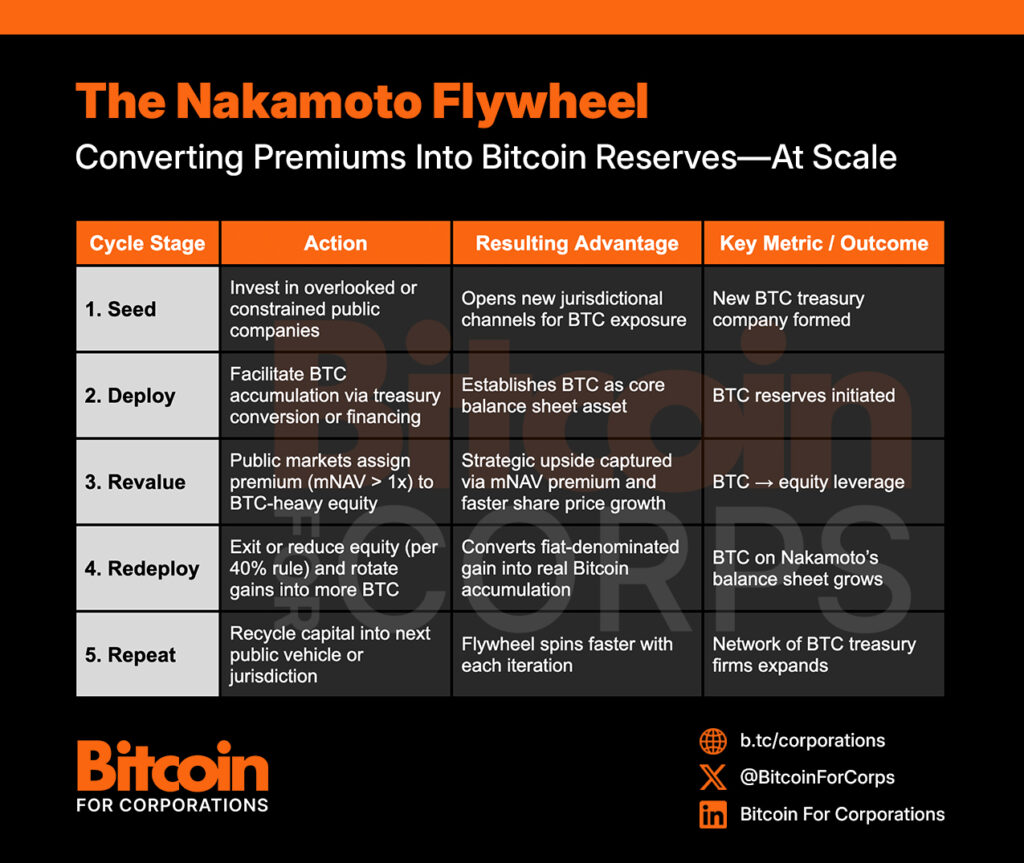Bitcoin Magazine

The Nakamoto Strategy: Seeding Bitcoin Treasury Companies in Every Capital Market
NOTE: This article presents the author’s perspective on the likely structure and future implications of Nakamoto’s strategy. It is a forward-looking analysis, not a statement from Nakamoto or its employees. Until the proposed merger closes, Nakamoto’s strategic execution remains subject to change. The analysis reflects public materials, early actions, and directional signals observed to date.
Introduction: From Treasury Strategy to Global Bitcoin Refinery
The Nakamoto strategy offers a new framework for capital formation in the age of Bitcoin. Rather than viewing Bitcoin solely as a reserve asset, Nakamoto is pursuing an approach that uses Bitcoin as a foundation for constructing a more dynamic and globally integrated capital structure.
The strategy involves more than simply accumulating BTC on a balance sheet. Nakamoto treats Bitcoin as a base layer of value and pairs it with public equity as a leverage layer—strategically deploying capital into smaller, high-potential public companies. The goal is to compound exposure, improve market access, and support the growth of a decentralized, Bitcoin-native financial ecosystem.
Already, UTXO Management has provided examples by seeding and supporting several high-profile Bitcoin treasury companies:
- Metaplanet (TSE: 3350) – Japan’s fastest-growing public Bitcoin company with 13,350 BTC, and #1 performing public company of 2024 out of 55,000 globally.
- The Smarter Web Company (AQUIS: SWC) – A UK-based web services firm that IPO’d with a BTC treasury strategy and has returned more than 100x since listing.
- The Blockchain Group (Euronext: ALTBG) – Europe’s first Bitcoin treasury company, with over 1000% BTC yield YTD 2025.
Backed by over $750+ million in capital, Nakamoto can scale this strategy globally—market by market, exchange by exchange, one Bitcoin treasury company at a time.
As Bitcoin increasingly functions as the emergent global hurdle rate for capital—strategies that generate returns in excess of Bitcoin itself become especially valuable. Nakamoto’s model is designed not just to preserve value in BTC terms, but to compound it. In that context, firms capable of consistently outperforming Bitcoin through disciplined BTC-denominated strategies are likely to earn outsized attention—and may increasingly attract capital as investors seek returns above the Bitcoin benchmark.
The Nakamoto Strategy Explained
The strategy rests on a straightforward insight: market access constraints are as important as Bitcoin itself. In many jurisdictions, institutional capital cannot buy or custody Bitcoin directly. But that same capital can buy public equities that hold Bitcoin as a treasury reserve.
This creates a specific opportunity:
- Seed new Bitcoin treasury companies: These are established in jurisdictions where access to BTC is structurally constrained, or where no such companies yet exist.
- Deploy Bitcoin strategically: BTC may be contributed directly or indirectly through equity financing mechanisms like PIPEs, warrants, or structured investments.
- Enable public market revaluation: These companies may begin to trade at a premium to the value of their BTC holdings (an mNAV expansion).
- Recycle capital through appreciation: Nakamoto can participate in this cycle and may reinvest in additional companies or accumulate further BTC.
The Nakamoto Flywheel below illustrates how equity premiums from public markets are strategically converted into long-term Bitcoin reserves. This repeatable model compounds Bitcoin-denominated value with each cycle—building balance sheet strength at global scale.

Key Mechanics: How the Strategy Multiplies Value
mNAV Arbitrage and Strategic Premium Capture
The Nakamoto strategy generates value by leveraging the structural dynamics of public markets and the constrained nature of Bitcoin access in many jurisdictions. One of the foundational mechanisms of the Nakamoto strategy is mNAV (multiple of Net Asset Value) arbitrage. When Nakamoto allocates capital to a Bitcoin treasury company in a jurisdiction where no other compliant BTC exposure vehicles exist, that company often begins trading at a multiple of its net Bitcoin holdings. This outcome assigns a strategic premium to Nakamoto’s deployed capital and effectively increases the market value of Bitcoin originally acquired at or near spot.
BTC Yield as the Core Performance Metric
Rather than focusing on traditional accounting metrics, Nakamoto evaluates performance in Bitcoin-denominated terms—specifically by tracking Bitcoin per diluted share. This measure, referred to as BTC Yield, captures the compounding benefit when a treasury company increases its Bitcoin holdings at a rate faster than its equity issuance. This reinforces long-term alignment with Bitcoin-native value creation.
Nakamoto also tracks look-through BTC ownership—its proportional claim on Bitcoin held across portfolio companies—as a secondary KPI, ensuring every equity move is benchmarked in Bitcoin terms.
While most Bitcoin-treasury companies rely heavily on repeated equity issuance—diluting existing shareholders in order to grow BTC-per-share, Nakamoto can compound holdings without dilution by running what is referred to as the mNAV² strategy. In practice, this means:
- Seed at Intrinsic Value: Nakamoto launches or invests in a Bitcoin treasury company at or near 1× mNAV—meaning the equity is priced roughly in line with the company’s net Bitcoin holdings.
- Unlock the Premium: Public markets re-rate the company, assigning a valuation multiple above its Bitcoin holdings due to scarcity, strategic positioning, or narrative momentum—creating an mNAV premium.
- Recycle Without Dilution: Nakamoto harvests a portion of the appreciated equity, redeploying the proceeds into additional BTC or new ventures—without issuing new Nakamoto shares, enabling BTC-per-share growth through capital efficiency.
As competition among listed treasury vehicles intensifies, markets are likely to reward the firms that can expand BTC-per-share through non-dilutive mechanisms. mNAV² makes that outcome native to Nakamoto’s playbook, turning balance-sheet efficiency itself into a competitive moat.
Closing the Institutional Access Gap
Jurisdictional limitations prevent many institutional investors from directly holding Bitcoin. However, they are often permitted to invest in public equities that hold BTC as a treasury asset. Nakamoto addresses this asymmetry by seeding and supporting regionally compliant public vehicles that serve as legal and practical conduits for institutional Bitcoin exposure.
Advantages of Operating Through Public Markets
By using public markets as its operational arena, Nakamoto benefits from transparency, ongoing liquidity, and efficient price discovery. These attributes allow it to recycle capital efficiently and expand into new geographies quickly. Unlike traditional private market structures, this approach supports scale, visibility, and regulatory alignment in real-time.
The 40% Rule: Redeploying Gains Into Bitcoin
A key structural requirement of the Nakamoto strategy is compliance with the Investment Company Act of 1940, which mandates that no more than 40% of Nakamoto’s balance sheet can consist of securities such as public equities. Bitcoin, classified as a commodity, does not count toward this limit.
This regulatory boundary shapes how Nakamoto must operate:
- As equity positions in Bitcoin treasury companies appreciate, Nakamoto is compelled to sell down those stakes to stay within the 40% threshold.
- This naturally reinforces the strategy’s focus on cycling gains from equity back into Bitcoin—accelerating BTC accumulation.
- To manage this constraint, Nakamoto has begun using innovative structures such as Bitcoin-denominated convertible notes. These instruments help fix asset exposure, enabling gradual conversion and avoiding sudden threshold breaches.
The cap is not a limitation on ambition—it’s a forcing function for capital discipline and strategic BTC reinvestment. As Nakamoto’s balance sheet grows, so does its capacity to hold larger equity positions—always with Bitcoin as the core reserve asset.
Strategic Instruments: Bitcoin-Denominated Convertible Notes
To manage compliance with the 40% securities threshold and mitigate volatility exposure, Nakamoto is likely to rely on Bitcoin-denominated convertible note structures in future deployments. These instruments offer a flexible way to structure exposure—allowing Nakamoto to fix the value of an investment on its balance sheet while retaining the option to convert into equity over time.
This structure presents several strategic advantages:
- Regulatory Buffer: Because conversion is optional and can be staged, these notes help delay classification as securities—preserving balance sheet headroom under the 40 Act.
- Gradual Entry and Exit: Nakamoto can incrementally convert notes as needed, smoothing market impact and aligning exposure with evolving balance sheet capacity.
This approach has already shown promise in models pursued by The Blockchain Group and H100, where similar structures have enabled Bitcoin-native capital deployment without triggering regulatory friction. If scaled appropriately, Bitcoin-denominated convertibles could become a defining instrument in Nakamoto’s toolkit—one that aligns capital strategy with both performance and compliance.
Addressing Criticism of the Nakamoto Strategy
Navigating Tax Complexity
A recurring concern centers around the tax consequences of transferring Bitcoin between entities. In many jurisdictions, such transfers can trigger taxable events, reducing capital efficiency. Nakamoto mitigates this risk by avoiding direct BTC transfers and instead utilizing equity-based structures—such as PIPEs, warrants, and joint ventures—that provide exposure without incurring immediate tax obligations.
Interpreting mNAV Premiums and Narrative Risk
Critics often question the durability of mNAV premiums, suggesting they may be driven more by market hype than fundamentals. Nakamoto responds to this concern by focusing on Bitcoin-per-share growth rather than valuation multiples alone. The firm emphasizes BTC Yield as a more reliable metric and prioritizes tangible BTC accumulation through recapitalizations and disciplined capital deployment.
Governance and Operational Influence
Some observers have expressed concern about Nakamoto’s degree of influence over the companies it supports. Nakamoto does not aim to control daily operations but ensures strategic alignment through governance rights, board representation, and equity stakes. This structure allows Nakamoto to influence treasury policy and maintain Bitcoin-centric discipline without compromising the autonomy of each company.
Managing Market Volatility and Compression Risk
The potential for mNAV compression—particularly in risk-off environments—is a known challenge. Nakamoto mitigates this risk by focusing on jurisdictions with low initial valuations and unmet demand for Bitcoin exposure. Even if valuation multiples contract, the companies Nakamoto supports continue to hold BTC on their balance sheets, preserving intrinsic value regardless of market sentiment.
Capturing Value in a Bitcoin-Denominated Model
A related concern involves how Nakamoto captures tangible value from the companies it helps establish or support. Unlike models that rely on dividend payments or near-term liquidity events, Nakamoto benefits through long-term strategic equity stakes, pre-IPO warrant structures, and equity appreciation tied directly to BTC-per-share growth. This approach enables value capture that aligns with its thesis of Bitcoin-denominated performance, without compromising the capital structure or autonomy of the underlying companies.
Differentiation from Traditional Private Equity Models
Comparisons are often drawn between Nakamoto’s strategy and private equity investing. While there are structural similarities, Nakamoto distinguishes itself through its liquidity profile, public market transparency, and alignment with Bitcoin-native accounting. Rather than operating as a fund, Nakamoto functions as a public infrastructure builder—identifying underserved markets, constructing regulatory frameworks, and absorbing early-stage risk in order to unlock institutional Bitcoin access at scale.
The Role of Nakamoto vs. Direct Investment
Some critics question whether Nakamoto is simply a middle layer between investors and the companies themselves—arguing that sophisticated capital could bypass Nakamoto and invest directly. In practice, however, Nakamoto delivers differentiated value by sourcing deals in overlooked markets, architecting compliant listing structures, and catalyzing early demand. It acts as a bridge between Bitcoin-native capital and traditional financial systems, taking on the narrative and structural lift that many institutions are unwilling or unable to initiate alone.
The irreplaceable edge for Nakamoto is deal flow. Nakamoto can source, structure, and price transactions at the moment of inception—access that simply isn’t available to most outside capital until valuations have already moved.
Conclusion: Nakamoto and the Formation of Bitcoin-Native Capital Markets
The Nakamoto strategy represents an emerging capital architecture centered around Bitcoin. By enabling market access, accelerating public-market velocity, and aligning incentives around BTC-per-share accumulation, Nakamoto is helping build a new generation of treasury-first public companies.
With over $750 million raised, operating examples across Tokyo, London, and Paris, and a growing network of prospective listings, Nakamoto is executing on a strategy designed to bridge the gap between capital markets and Bitcoin adoption.
As traditional financial institutions continue to face structural and regulatory barriers to holding BTC directly, the model Nakamoto is developing may offer a scalable, compliant path forward. It’s not just a capital strategy. It’s a structural response to Bitcoin’s growing role in global finance.
Disclaimer: This content was written on behalf of Bitcoin For Corporations, and is not a statement from Nakamoto or Kindly MD, Inc. This article is intended solely for informational purposes.
This post The Nakamoto Strategy: Seeding Bitcoin Treasury Companies in Every Capital Market first appeared on Bitcoin Magazine and is written by Nick Ward.




